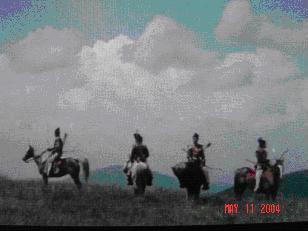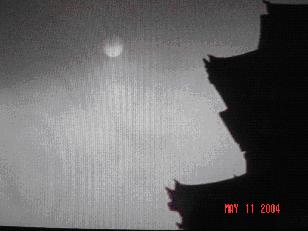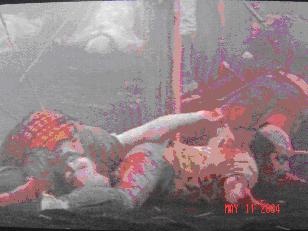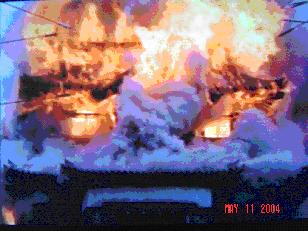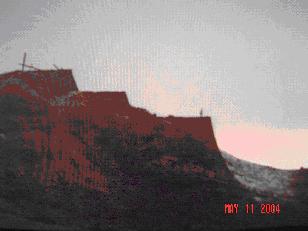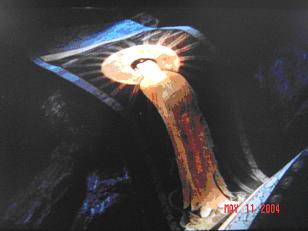 |
 |
|||||||||||||
|
Cinematic Transcendence in Akira Kurosawa's Ran Kurosawa's accomplishment is in magnifying a play too big for the stage
By Ng Teng Kuan
While King Lear is regarded as arguably the greatest of all Shakespearian tragedies, it is not uncommon for postmodern critics to bring "a deep distrust of all attempts at closure" in their approach to text, the inherent complexities of which seem to suggest the "negation of the possibility of unity, coherence, and resolution." However, in Ran, Akira Kurosawa's filmic adaptation of the play, whatever indeterminacy that might be evident in King Lear appears to have become subordinated to an essentially Aristotelian definition of tragedy, marked by "the representation of an action that is complete and whole" through "unity of plot." Through a comparative analysis of certain key cinematic elements in Ran, we will see how the inherent nature of the film medium is harnessed to present not only a picture of profound existential desolation, but also a deeper philosophical discourse exploring the nature of aesthetic and religious transcendence. Though perhaps overstated, it is not without reason that John Danby argues that King Lear "can be regarded as a play dramatizing the meanings of the single word, 'Nature.'" Let us thus begin by considering how Ran reinterprets this theme. In any staging of King Lear, one of the largest challenges is proffered by the magnitude of meteorological cataclysm described:
To a certain extent, the practical difficulty of credibly depicting lines like these in the theater leads us to wonder, along with A. C. Bradley, if King Lear is indeed "too huge for the stage." We might hence say that the limitations of the stage fail to do full justice to the greater significance of the weather motif: the dialectic between creation and creature, between Nature and "man's nature."
Fig. 1 the "great stage" of nature that Ran opens upon.
Fig 2. Pillow shot of pillar of cloud. The first thing that an audience of Ran is confronted with, conversely, is its grand portrayal of natural phenomena. As opposed to the confined throne room conventionally portrayed in productions of King Lear, Ran opens in a verdant mountain range as vast as the eye can see (see Fig. 1). As the film progresses, we are periodically presented with stills capturing the terrible glory of nature: a pillar of cloud suspended in ominous stagnancy, while old Hidetora sleeps (see Fig 2.); vermillion rays straining through the clouds, now covering the sun when Saburo and Tango are wrongfully exiled; the blinding whiteness of the sun, beating down relentlessly upon a Hidetora hunched in sorry disbelief after being forsaken by Jiro. On the simplest level, these shots act as demarcations of a new scene (as curtains do on the stage), marking both the time of the day as well as its inexorable passage. But more than that, they reveal a discourse that operates on the "ontological level" where, as Andrι Bazin discerns in What is Cinema?, "the effectiveness of the cinema has its source." On the one hand, it is clear that these shots of natural phenomena serve to establish the "great stage of fools" upon which the dramaturgical spirit of King Lear is immanently translated. For what stage could be greater than the actual realm of nature, captured by the mechanical eye of the camera? Whereas the storm in Act II, Scene iv of the play seems to develop somewhat abruptly as Lear learns of his betrayal by Regan, and whereas its revivification from the text would be heavily dependent on the audience's imagination, the comparatively sustained use of sympathetic background in Ran effectively hypostatizes the "tempest in [the] mind" (II.iv.12). To further employ Bazin's insights on the relationship between film and theater:
Bearing traces of the distinction between text and speech that Jacques Derrida distinguishes in the history of Western metaphysics, it may be argued that Ran overcomes the limitations of the stage to present, with a cinematic spontaneity that will forever elude theatrical productions of King Lear, the present reality of chaos. But on the other hand, as George Steiner points out in Real Presences, though "all good art and literature begin in immanence," they "do not stop there," but go further to traverse the "continuum between temporality and eternity, between matter and spirit, between man and 'the other.'" Therefore, if a full appreciation of Ran is to be attained, we must engage the nature of the transcendence that it presents primarily through such stills of natural phenomena. For according to Paul Schrader, "without stasis, there is no expression of the Transcendent, and without expression of the Transcendent, there can be no fundamental interrelation between cultures," between the seemingly disparate worlds of King Lear and Ran. The stills that we see find their probable roots in what Noel Burch refers to as Yasujiro Ozu's classic, transitory "pillow shots," which "never contribute to the narrative proper [but instead, depict spaces] that are invariably presented as outside the diegesis, as a pictorial space on another plane of 'reality' as it were." In Ran, we find this technique appropriated to its fullest during the spectacular battle for the Third Castle - a scene which serves not only as a crucial turning point within the narrative, but also as a stunning exemplification of the "cinematic beauty" that Kurosawa himself identifies as the "essence of cinema." The beginning of this sequence is marked by a shot of the clouds culminating in a looming, overcast grayness. It is under this backdrop that we witness the momentous spectacle (regarded by Aristotle as "an essential part of tragedy") of war, as a melee of colors bleed silently upon the battlefield rivulets of blood navigating a sea of impaled corpses; men with colored flags on their backs running, hacking, collapsing, dying; smoke streaming from burning towers, ascending and commingling with the ashen mist to the ostensible end of illustrating the "image of that horror," as crudely described by Lear: "kill, kill, kill, kill, kill, kill!" And during this six-minute long sequence there is the interjection of similar pillow shots, most poignantly one that sets the gradually dissipating sun next to the silhouette of a tower (see Fig. 3) ostensibly representing the vanity of human ambition (in the words of Qoholeth in Ecclesiastes 9:9) "under the sun". For the most part, the violence shown stays faithful to the spirit of King Lear: for instance, Cornwall's gouging out of Gloucester's eyes (and squashing them underfoot) finds an equally vivid parallel in a shot where a soldier tugs plaintively at the chaff of the arrow embedded in his eye. Still, it is clear that the proportion of carnage in Ran more reminiscent of a Homeric epic by far exceeds the Shakespearean tragedy. In King Lear, the defeat of Cordelia's troops takes place with hardly any description of the war; at the start of Act V Scene iii, we find out rather suddenly that the French have lost, when we see Lear and Cordelia entering the stage as prisoners a terseness owing, in all probability, to the mimetic limitations of theater. In contrast, unfettered by the confines of "time and space," Kurosawa is more than able to depict the full "terrible beauty" (to borrow Yeats's succinct phrase) of both the war and the inclement "extremity of the skies," as the viewer is held spellbound by the mysterium tremendum so powerfully evoked by the scene.
Fig. 3. Pillow shot before and during the battle for the Third Castle. From the perspective of cinematic modernism, the visceral potency of these pillow shots relies heavily on what is known as the "Kuleshov effect," which P. Adams Sitney identifies as "the foundation of [modernist filmmakers'] emotional manipulation of viewers." In the same way that the same expression of an actor is invariably construed in radically different ways depending on the context that the shot is set within, the counterpoising of an otherwise "neutral" still of the skies with scenes of gory battle compels us to perceive that nature itself were partaking in the selfsame woes of war. As such, Ran's montage brings the sympathetic background of King Lear to its technical consummation, quite literally showing how, as Edmund would put it, due to "surfeits of our own behavior, we make guilty of our disasters the sun, the moon, and the stars"(I.ii.119-120). Nevertheless, because in the nature of filmic objectivity as in Buddhist philosophy "man in the world enjoys no a priori privilege over animals and things," Kurosawa forces us to question our intuitive predeterminations: which is the shot, which is countershot, and is there a necessary order of primacy? Moreover, if montage is to operate on what Sergei Eisenstein calls the "dialectic principle" of the "dynamic comprehension of things," and if the mutual interpenetration of concepts is to be the hallmark of a genuine dialectic, the possibility of the reverse must then be conceded. That is to say, more than acting as some kind of blank screen upon which human emotions are projected, the universe of Ran also bears quiet testimony to Bashō's Zen aesthetic principle that "high art is all one in nature." In this light, the breathtaking still of the smoldering citadel at the end of the sequence - tongues of flame licking the unfurling billows of smoke (see Fig. 5) - mirrors not only the "sacred radiance of sun" (now desecrated, as it were) shining amidst the pale clouds (see Fig. 8.), but also the dark enlightenment that Hidetora bears as he staggers out of the fortress in blighted absence. As Steiner argues, "the aesthetic is the making formal of epiphany. There is a 'shining through'" of truth and beauty regardless of the form they might take - from some higher "plane of reality." The discourse of transcendence at work within the entire sequence is further conveyed through the superimposition of a haunting, ethereal tune drowning the cacophony from all that is erupting. What we hear appears to be the very music of hell; as one of Hidetora's wounded vessels inform him, "We are surrounded, overwhelmed! We are truly in hell!" Kurosawa's advice to aspiring filmmakers in Something Like An Autobiography offers some elucidation to our understanding the technique adopted here:
Deaf to the howling of pained men, the cackling of fire, and the volley of gunshots ringing out, we cannot but be estranged from the events of the battlefield (See Fig 4.). This, in effect, thrusts us into the perspective of "the eye of God," so to speak, fostering an oppressive sense of impotence at our inability to do anything other than gape at the phantasmagoric sequence before our eyes, that we might experience the veracity of Tango's lament towards the end of Ran: "They see us killing each other, over and over again, since time began. They can't save us from ourselves That's how the world is made. Men prefer sorrow over joy, suffering over peace. They revel in bloodshed, they celebrate murder."
Fig 4. "They revel in bloodshed, they celebrate murder."
Fig.5 Burning citadel at the end of sequence. In synthesis with the "objectivity of cinema," the very temporal nature of music heightens our apprehension of the inevitability of death, of how life is a "[crawling] towards death;" as Steiner proposes, "the time music 'takes,' and which it gives as we perform or experience it is the only free time granted to us prior to death" (1.1.40). Productions of King Lear, on the one hand, will ultimately remain as performances, the theatricality of which is buttressed (according to Maynard Mack) by the "mythic bent" of the Shakespearian text which "abandons verisimilitude to find out truth." In Ran, on the other hand, the camera that "cannot lie" (a premise that echoes the "immutable" scriptural truth that "it is impossible for God to lie") gives us "what is experienced as the truth of life" (Hebrews 6:18). And by so doing, we see how Kurosawa appropriates the film medium as a real metaphor for Satori (enlightenment), which entails "knowing the world as it really is." But at the same time, since as a rule of thumb his films eschew the "ineffective" use of music as mere accompaniment in favor of working "in terms of counterpoint of sound and image," it would be reasonable to suggest that, somehow, the sense of detachment we feel ought not to be the proper response to this bleak existential reality. While this in turn raises further questions concerning the ethics of watching, it seems that if some resolution to the philosophical aporia of the film is to be acquired, it would have to be through an essentially affectivisitic hermeneutic. Edgar's loaded words at the end of the play may be taken as a prescient typology of such a hermeneutic:
As we have seen, what Kurosawa accomplishes in Ran can be principally regarded as a development and magnification of King Lear's tragic vision. But he achieves this end not only through the natural capabilities of the film medium, but also through significant alterations to the original plot. As "cheerless, dark and deadly" as the "tough world" of King Lear may be, there is however infinitesimal some glimpses of hope. With Goneril and Cordelia dead, Edmund's repentance ("Some good I mean to do / Despite of mine own nature", V.iii.241-242) intimates the vanquishing of all extant villainy. Also, even through all his vicissitudes, Edgar ardently professes that the "gods are just" (V.iii.169). And though the death of Lear and Cordelia indicate the collapse of the old monarchic order, we are assured that a new kingdom will be established under the Duke of Albany - who has hitherto demonstrated a good measure of fortitude and compassion a kingdom that will probably be eventually inherited by the noble Edgar. It is in view of these glimmers of light, and in view of Lear's awakening from his follies, that critics like Bradley go as far as suggesting "The Redemption of King Lear" as a subtitle to the play. In comparison, the pathos of Ran's plot proves far more unrelenting in its gravity. To begin with, the sheer story of "brothers [dividing]" and the "bond cracked 'twixt son and father" gains greatly in import through translation to the context of Japanese cinema; it is a context wherein, as Joseph Anderson and Donald Richie point out, the individual's unyielding allegiance to the family has often prevented the attainment of a truly tragic scope (1.2.106-107). Furthermore, compared to the aged Gloucester, Hidetora's blinding of Tsurumaru as a child appears to be an act of severer cruelty. While a case might be made for the new order that will be founded under Fujimaki, it is clear that his stature in the film does not arouse in us the same kind of hope that Edgar does at the end of King Lear. And above all, even the saintlike Lady Sue, the embodiment of Buddhist devotion and placidity, is hideously decapitated when she leaves the promise of safety in search of a benign old maidservant and her brother's flute. At the end of the film, a procession of troops bear their dead lords' bodies amidst the mournful hues of an indeterminate twilight in the closing scenes, as the lost, blind Tsurumaru is left - without kith or kin, and without his flute, the "only pleasure left to [him]." If the aesthetic and religious vision in Ran were unequivocally Buddhist, we would need to go no further than reading this ending as an affirmation of the idea of mujō, the ephemerality of all earthly things. As Lady Sue tells Hidetora, "the Buddha embraces all things" in perfect equanimity including this panorama of existential desolation. But by giving Lady Sue over to a senseless, macabre death, Kurosawa disables any attempt at a didactically Buddhist interpretation. In fact, in concluding Ran with three progressive cut-ins to the lonely figure of Tsurumaru, before parallelistically cutting back out onto the red, dusty cliff the latter is perched upon (see Fig 6.), it is quite clear that Tsurumaru is the one whom we are led to identify most keenly with. In Bazin's terms, as the sole figure on the screen Tsurumaru "is no longer [just] the focus of the drama," but has become "the center of the universe," since "there is nothing to prevent us from identifying ourselves in imagination with the world" before us.
Fig. 6 two progressive cut-ins and cut-outs of Tsurumaru at the end. Therefore, we may contend that there is, on the one hand, the implicit rejection of the Buddhist conception of transcendence in Ran. Akin to Tsurumaru's intractable situation, the ending of the film renders it implausible for us to "try to be like [Lady Sue]:" what is there, or more pointedly, who is there, to "forget and forgive?" (4.7.84) Unable to fend even for its most earnest devotee, the fallen, lifeless scroll of the Buddha Amida (see Fig 7.) attests to the impotence not only of its promise ("This scroll of Amida will protect you in my place"), but also of its philosophical aesthetics, in its inability to satisfactory address the grim existential realities of Ran's world. As Steiner observes:
And even as the faithful would no doubt aver to the belief that Lady Sue ultimately attains "rebirth in a land of pure bliss," in Kurosawa, as in Ozu, there can neither be soteriological recourse to a "resigned acceptance of [this Pure Land] environment," nor solace to be sought in a Zen religious aesthetic.
Fig. 7 Fallen scroll of Buddha Amida
Fig 8 a "shining through." But on the other hand, it may be affirmed that Kurosawa goes one step further than a nihilistic rejection of Buddhism. As we have seen, Ran re-presents from King Lear, with sad, lavish cinematic beauty what the Apostle Paul would term as the travailing of a creation "subjected to futility" and to the "bondage of corruption" (Romans 8:20-21). In the final analysis, if like the blinded Gloucester we "see [this] feelingly," are we not impelled to protest, along with Kent: surely this cannot be "the promised end" of Ran, and of this very life itself? By brilliantly appropriating the inherent objectivity of the film medium into a uniquely transcendental style, Kurosawa presents in Ran a subliminal contemplation upon the immanence of some inviolable, inarticulable glory in a craven world, whether this glory be incarnated in the immense conflagration ravaging the Third Castle, in the awesome splendor of a pillar of cloud, or even in Hidetora's very human frame, once august, now wizened. If there is to be a more robust explanation to the nature and destiny of man, it is an explanation whose word the universe of Ran and perhaps Kurosawa himself has yet to fully comprehend. _____
|
|
|||||||||||||
Copyright © 2001-2025 The Authors
Privacy Policy | Terms of Use |
E-mail
